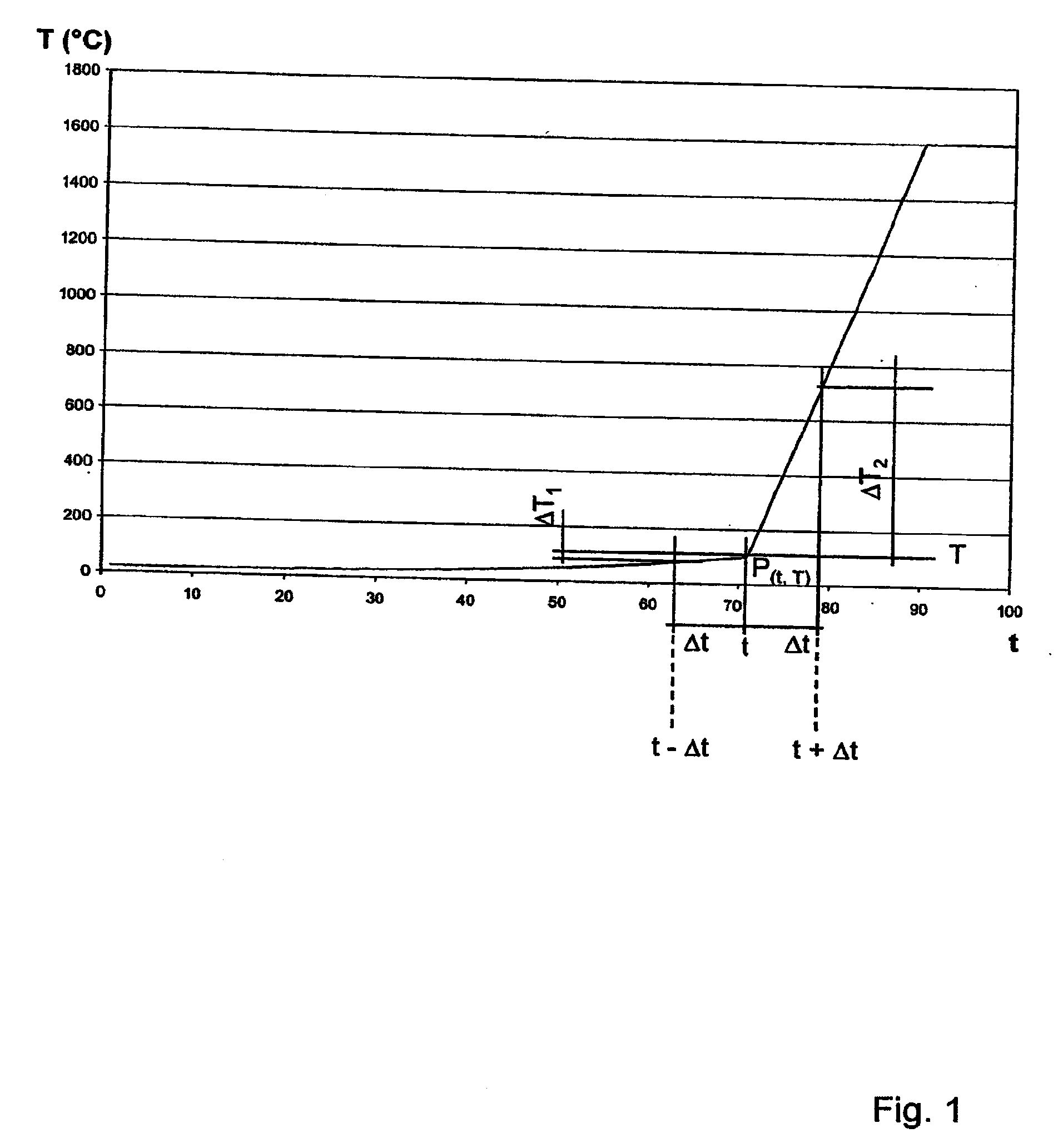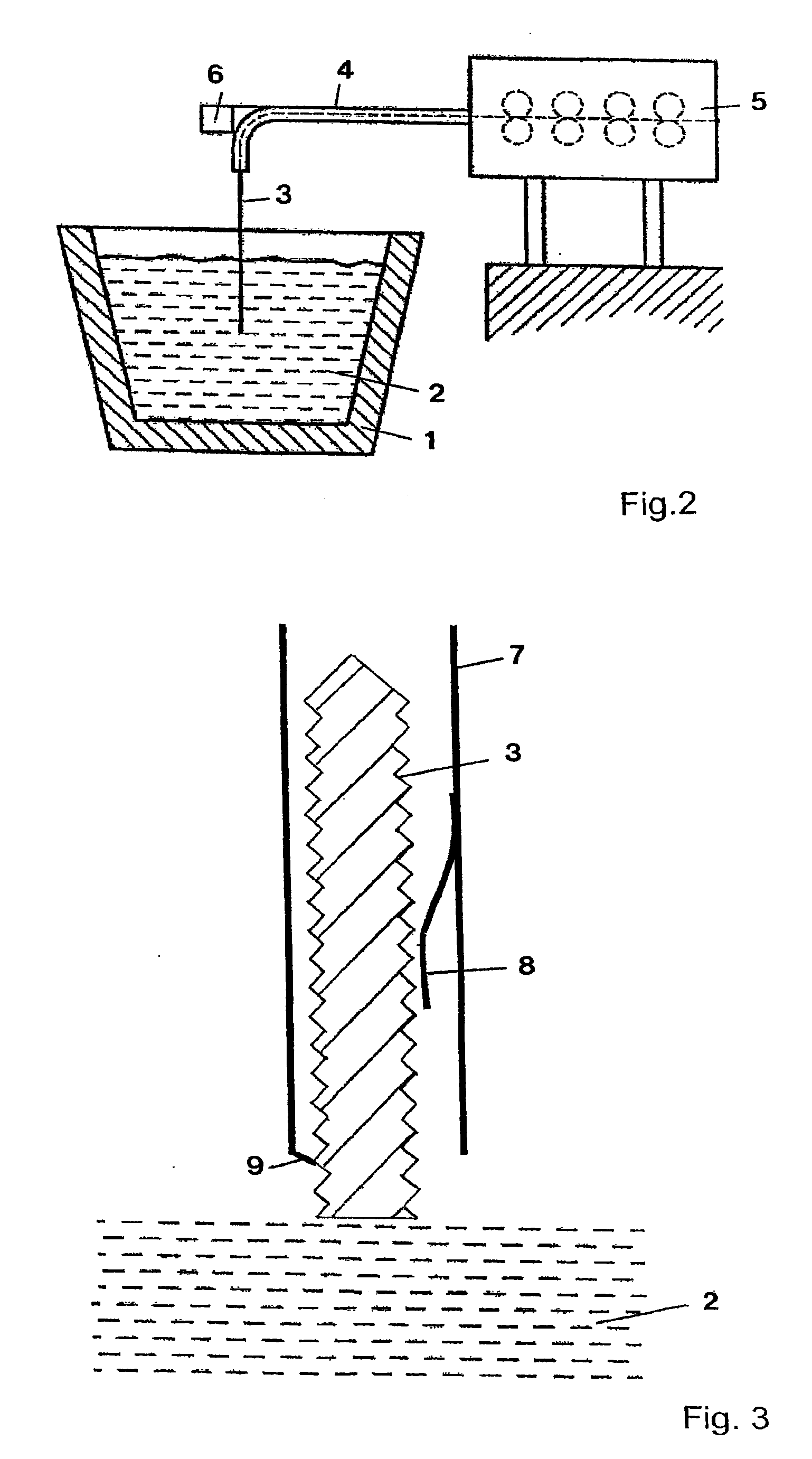[0007]A temperature course of this kind means that from a particular point in time onwards the heating curve in principle has a bend (quasi discontinuity), at which the heating speed considerably increases compared with the previous course. It has been proved that a mechanical movement of the optical fiber or its immediate environment takes place, the magnitude of which depends on the size of the change in the heating speed and the shortness of the corresponding time interval. The greater the change in the heating speed and the smaller the time interval Δt is, the greater is the mechanical movement of the fiber or its immediate environment at the time of this quasi erratic change in the heating curve. This movement assists the immersion of the optical fiber in the molten bath and the replacing of the tip of the optical fiber, which is practically pushed off by the suddenly arising movement (vibration), so a new end of the glass fiber, not yet damaged by high temperatures, can be tracked.
[0009]It is appropriate that the temperature T0 of the optical fiber allocated to the point in time t0 between the two time intervals is a maximum of 600° C., preferably a maximum of 200° C., more preferably a maximum of 100° C. The temperature of the actual optical fiber in the narrower sense, in other words the temperature of the quartz glass should be considered in this. The lower this temperature T0, on which the change in the heating speed is based, the stronger and more effective this change can be.
[0010]The speed at which the optical fiber is immersed in the molten metal bath or fed thereto corresponds to the speed at which the vitreous structure of its tip is destroyed, so new glass fiber material is constantly fed which is suitable for receiving and passing on radiation, without radiation losses arising owing to a destroyed fiber structure.
[0012]An intermediate layer of this kind is heated during the immersion of the optical fiber in the molten metal bath or a layer of slag above it. It has surprisingly been proved that the combination of a metal tube and an intermediate layer arranged beneath it, made of a powder or a fibrous or granular material, results in this material of the intermediate layer suddenly expanding greatly during heating, from a particular point onwards, in a heating curve with the presence of gases, namely if the metal tube is heated so much that it can no longer withstand the pressure which arises inside the metal tube, because of the expansion of the gases of the intermediate layer conditional on heat. In this case, fast rising stresses form inside the metal tube, until it suddenly cracks or is destroyed in some other way, so that the cover of the optical fiber moves away from the fiber practically explosively. In general, the device according to the invention is characterised in that during or after the destruction of the metal tube, the intermediate layer very quickly disintegrates as a layer, its parts moving away from the fiber. In this way, on the one hand the optical fiber is very quickly and suddenly exposed to the molten metal bath at its immersed end and on the other hand the advance of the tip of the optical fiber into the molten metal bath is made considerably easier.
[0014]The cover preferably has a vibrator or a vibrator is arranged on or next to the cover, to improve the release of the material of the cover from the optical fiber or the removal (breaking off) of the destroyed tip of the optical fiber. The vibrator may also be formed by the material of the intermediate layer, as it has been proved that the particles of the material of the intermediate layer move towards one another on heating, this movement taking place partially erratically, so vibrations arise within this material or within the intermediate layer.
[0017]The device according to the invention has, generally speaking, a cover for the quartz glass fiber, which on immersion into the molten metal bath is discontinuously destroyed. In this way, the optical fiber is kept for a relatively long time at a very low temperature. From a particular temperature onwards the fiber is heated erratically to the equilibrium temperature in the molten metal bath, so that the measurement can then take place very quickly before the optical fiber or its end immersed in the molten metal bath is destroyed. By continuously tracking the fiber into the molten bath at the same speed at which its immersed end is destroyed, there is always usable fiber material available in the molten metal bath for measuring. The tip of the fiber is continuously destroyed, so that the erosion face of the fiber is practically stationary. For this purpose, the fiber or its immersion end should reach the bath temperature at the moment its degradation begins (this so-called critical speed is in this case therefore identical to the erosion speed at which the erosion face of the fiber moves). If the erosion speed is lower than the critical speed, the fiber is destroyed before it reaches the bath temperature.
 Login to View More
Login to View More 


